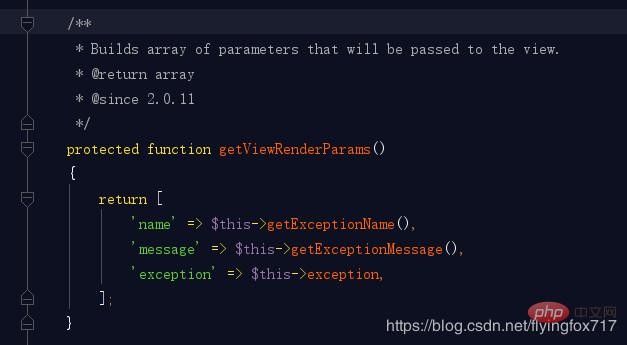Where is the yii error prompt location?
The yii error prompt location is under the "@app/views/site/error.php" path, and the default error, the error prompt action, is handled by the error action under the site controller.

Yii2 Modify the error prompt page style
yii2 The default error action is by default under the site controller error action to handle, the corresponding error view page is @app/views/site/error.php page.
return [
....其它配置
'components' => [
...其它配置
'errorHandler' => [
'errorAction' => 'site/error',
],
]
]The actions() method is rewritten in siteController, and the specified error action is from yii\web\ErrorAction Processing, by default the error view page error.php will inherit the layout file. We can modify the layout file of the error.php page by modifying the actions() method. At the same time, in order to set its error action for each controller, you can define a base The class BaseController inherits yii\web\Controller, and then other controllers inherit the base class, and override the actions method in the base class as follows:
public function actions() {
return [
'error' => [
'class' => 'yii\web\ErrorAction',
'layout' => false,
],
];
}class specifies the class that handles error information. When an error action occurs, yii \web\ErrorAction class takes over, layout specifies the error display page using the layout file, view the source code:

Return error message name (error name, such as 404), message (Simple information), exception (error object)
Recommended: "yii tutorial"
The above is the detailed content of Where is the yii error prompt location?. For more information, please follow other related articles on the PHP Chinese website!

Hot AI Tools

Undresser.AI Undress
AI-powered app for creating realistic nude photos

AI Clothes Remover
Online AI tool for removing clothes from photos.

Undress AI Tool
Undress images for free

Clothoff.io
AI clothes remover

AI Hentai Generator
Generate AI Hentai for free.

Hot Article

Hot Tools

Notepad++7.3.1
Easy-to-use and free code editor

SublimeText3 Chinese version
Chinese version, very easy to use

Zend Studio 13.0.1
Powerful PHP integrated development environment

Dreamweaver CS6
Visual web development tools

SublimeText3 Mac version
God-level code editing software (SublimeText3)

Hot Topics
 How to set the yii frame timestamp tutorial
Mar 06, 2025 pm 02:18 PM
How to set the yii frame timestamp tutorial
Mar 06, 2025 pm 02:18 PM
This tutorial demonstrates Yii Framework's timestamp management. It details using TimestampBehavior for automatic created_at and updated_at updates, offering customization options and comparing it to manual updates, database triggers, and custom be
 What Are the Best Practices for Using Yii in a Cloud-Native Environment?
Mar 18, 2025 pm 04:39 PM
What Are the Best Practices for Using Yii in a Cloud-Native Environment?
Mar 18, 2025 pm 04:39 PM
The article discusses best practices for deploying Yii applications in cloud-native environments, focusing on scalability, reliability, and efficiency through containerization, orchestration, and security measures.
 Comparison of Yii and Laravel frameworks What is the difference between Yii and Laravel frameworks
Mar 06, 2025 pm 02:17 PM
Comparison of Yii and Laravel frameworks What is the difference between Yii and Laravel frameworks
Mar 06, 2025 pm 02:17 PM
This article compares the PHP frameworks Yii and Laravel. Yii prioritizes speed and structure, while Laravel emphasizes developer experience and flexibility. Though both handle large-scale applications, Yii offers superior raw performance, while La
 How about yii framework? What is yii framework
Mar 06, 2025 pm 02:20 PM
How about yii framework? What is yii framework
Mar 06, 2025 pm 02:20 PM
This article introduces Yii, a high-performance PHP framework ideal for large-scale web applications. It highlights Yii's speed, security, and robust architecture (MVC), emphasizing its advantages over other frameworks like Laravel, Symfony, and Cod
 Pros and cons of yii framework Pros and principles of yii framework
Mar 06, 2025 pm 02:22 PM
Pros and cons of yii framework Pros and principles of yii framework
Mar 06, 2025 pm 02:22 PM
This article analyzes Yii framework's strengths and weaknesses. It highlights Yii's high performance, robust security, rapid development capabilities, and extensibility, but also notes a steeper learning curve and potential complexity for smaller pr
 Which is better between Yii framework and TP framework? The difference between Yii framework and TP framework
Mar 06, 2025 pm 02:21 PM
Which is better between Yii framework and TP framework? The difference between Yii framework and TP framework
Mar 06, 2025 pm 02:21 PM
This article compares Yii and ThinkPHP (TP) frameworks. The choice depends on project scale and developer experience. Yii, robust and mature, suits large, complex projects needing high performance. TP, simpler and faster for development, is better f
 How to call public functions yii How to call public functions yii Tutorial
Mar 06, 2025 pm 02:23 PM
How to call public functions yii How to call public functions yii Tutorial
Mar 06, 2025 pm 02:23 PM
This article details how to call and organize common functions in Yii applications. It advocates encapsulating functions within classes, ideally in a dedicated app/helpers directory, for improved reusability and maintainability. Different approache
 What Are the Key Considerations for Using Yii in a Serverless Architecture?
Mar 18, 2025 pm 04:33 PM
What Are the Key Considerations for Using Yii in a Serverless Architecture?
Mar 18, 2025 pm 04:33 PM
The article discusses key considerations for using Yii in serverless architectures, focusing on statelessness, cold starts, function size, database interactions, security, and monitoring. It also covers optimization strategies and potential integrati






